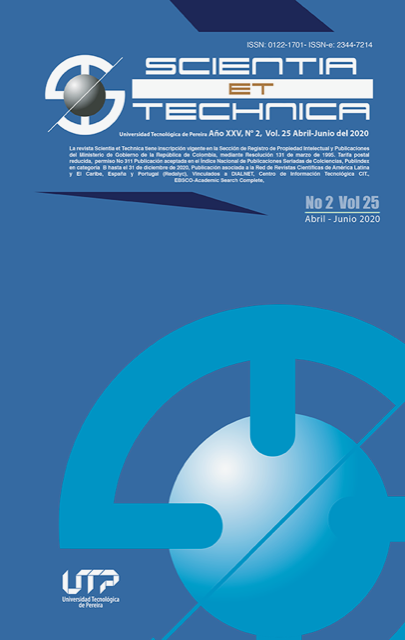Detection of structural alterations in metal bodies: An approximation using Fourier transform and principal component analysis (PCA)
DOI:
https://doi.org/10.22517/23447214.23501Palabras clave:
Análisis de componentes principales, alteraciones estructurales, Cuerpos Metálicos, transformada rápida de FourierResumen
In this theme some advances have been developed, verified in the background, where attempts have been made to determine the existence of structural alterations such as perforations, defective welding and dents in metal structures; a pattern of mechanical vibration that allows to differentiate each alteration has not yet been clearly defined. In this work, the data taking was carried out taking into account the position of the sensors, two beams were added without alteration, in order to be able to interact with the five configurations, which were adopted for the experimental design. To the tests of repeated measurements, in each configuration, analysis (ANOVA) was used for the validation of NULL hypotheses, and thus to determine the number of test to be treated. After having the defined matrices representing each configuration, in each anomaly, it is necessary to apply the principal component Analysis (PCA), to the data obtained by the calculation of the fast Fourier transform (FFT). And thus determine the number of components by means of three Criteria (Jollife, Kaiser and PVA), using a classification algorithm, which evaluates the percentage of classification vs lower standard deviation. In this analysis the descriptors were not calculated but the main components of each criterion were taken as a description tool. The process of extraction of characteristics was fundamental to determine the proper configuration in each alteration (fissure, welded, perforated, deformed). On the other hand, statistical parameters were calculated (average, standard deviation, variation factor, Euclidean distance) of each anomaly. Taking as descriptors.
Descargas
Descargas
-
Vistas(Views): 363
- PDF (English) Descargas(Downloads): 286
Publicado
Cómo citar
Número
Sección
Licencia
Derechos de autor y licencias
La revista es de acceso abierto gratuito y sus artículos se publican bajo la licencia Creative Commons Atribución/Reconocimiento-No Comercial-Compartir bajo los mismos términos 4.0 Internacional — CC BY-NC-SA 4.0.
Los autores de un artículo aceptado para publicación cederán la totalidad de los derechos patrimoniales a la Universidad Tecnológica de Pereira de manera gratuita, teniendo en cuenta lo siguiente: En caso de que el trabajo presentado sea aprobado para su publicación, los autores deben autorizar de manera ilimitada en el tiempo, a la revista para que pueda reproducirlo, editarlo, distribuirlo, exhibirlo y comunicarlo en cualquier lugar, ya sea por medios impresos, electrónicos, bases de datos, repositorios, discos ópticos, Internet o cualquier otro medio requerido.
Los cedentes mediante contrato CESIÓN DE DERECHOS PATRIMONIALES declaran que todo el material que forma parte del artículo está totalmente libre de derechos de autor de terceros y, por lo tanto, se hacen responsables de cualquier litigio o reclamación relacionada o reclamación relacionada con derechos de propiedad intelectual, exonerando de toda responsabilidad a la Universidad Tecnológica de Pereira (entidad editora) y a su revista Scientia et Technica. De igual forma, los autores aceptan que el trabajo que se presenta sea distribuido en acceso abierto gratuito, resguardando los derechos de autor bajo la licencia Creative Commons Atribución/Reconocimiento-No Comercial- Compartir bajo los mismos términos 4.0 Internacional — CC BY-NC-SA 4.0.
https://creativecommons.org/licenses/by-nc-sa/4.0/
A los autores, la revista Scientia et Technica tiene la obligación de respetarle los derechos morales (artículo 30 de la Ley 23 de 1982 del Gobierno Colombiano) que se les debe reconocen a estos la paternidad de la obra, el derecho a la integridad y el derecho de divulgación. Estos no se pueden ceder ni renunciar.



